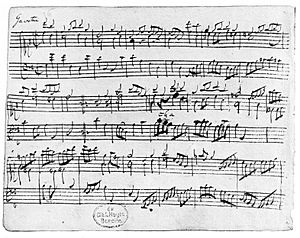French Suites (Bach) facts for kids
The French Suites (pronounced "swoots"), also known as BWV 812–817, are a set of six musical pieces. They were written by the famous composer Johann Sebastian Bach for a keyboard instrument (like a harpsichord or clavichord) between 1722 and 1725. These suites are like collections of different dance movements, all put together to create a longer musical work.
Contents
Why are they called 'French' Suites?
These suites weren't originally called 'French' by Bach himself. The name was given to them later, around 1762. A writer named Johann Nikolaus Forkel helped make the name popular in his book about Bach in 1802. He thought they were written "in the French manner."
However, this idea isn't quite right! Most of Bach's suites, including these, actually follow a style that's more common in Italy. For example, the "courante" movements in most of these suites are in the Italian style, even though the name "courante" sounds French. Bach also included other dance movements, like the "polonaise" in the sixth suite, which weren't typically French.
Some old copies of these suites were titled "Suites Pour Le Clavecin," which means "Suites for the Harpsichord" in French. This might be why people started calling them "French Suites."
What are the movements?
Each French Suite is made up of several different dance-like pieces, called movements. Here's a look at the movements in each suite:
Suite No. 1 in D minor, BWV 812
Suite No. 2 in C minor, BWV 813
- Allemande
- Courante
- Sarabande
- Air
- Menuet
- Menuet – Trio (in BWV 813a)
- Gigue
Suite No. 3 in B minor, BWV 814
- Allemande
- Courante
- Sarabande
- Angloise
- Menuet – Trio
- Gigue
Suite No. 4 in E♭ major, BWV 815
- Allemande
- Courante
- Sarabande
- Gavotte
- Air
- Menuet
- Gigue
There's also another version of Suite No. 4 (called BWV 815a) that has three extra movements: a Prelude, a second Gavotte, and another Menuet.
Suite No. 5 in G major, BWV 816
- Allemande
- Courante
- Sarabande
- Gavotte
- Bourrée
- Loure
- Gigue
Bach started writing the first part of this suite in 1722 for his second wife, but he didn't finish it until 1723. The Gigue movement often sounds like a musical chase, where different parts of the music seem to answer each other.
Suite No. 6 in E major, BWV 817
- Allemande
- Courante
- Sarabande
- Gavotte
- Polonaise
- Bourrée
- Menuet
- Gigue
Legacy
Even today, Bach's music is still popular! The Menuet from Suite No. 3 in B-minor BWV 814 was one of the music options you could choose in the Nintendo Game Boy version of the video game Tetris.
See also
 In Spanish: Suites francesas para niños
In Spanish: Suites francesas para niños
- Works for keyboard by Johann Sebastian Bach
- Partitas, BWV 825–830
- English Suites, BWV 806–811
- Bach compositions printed during the composer's lifetime


